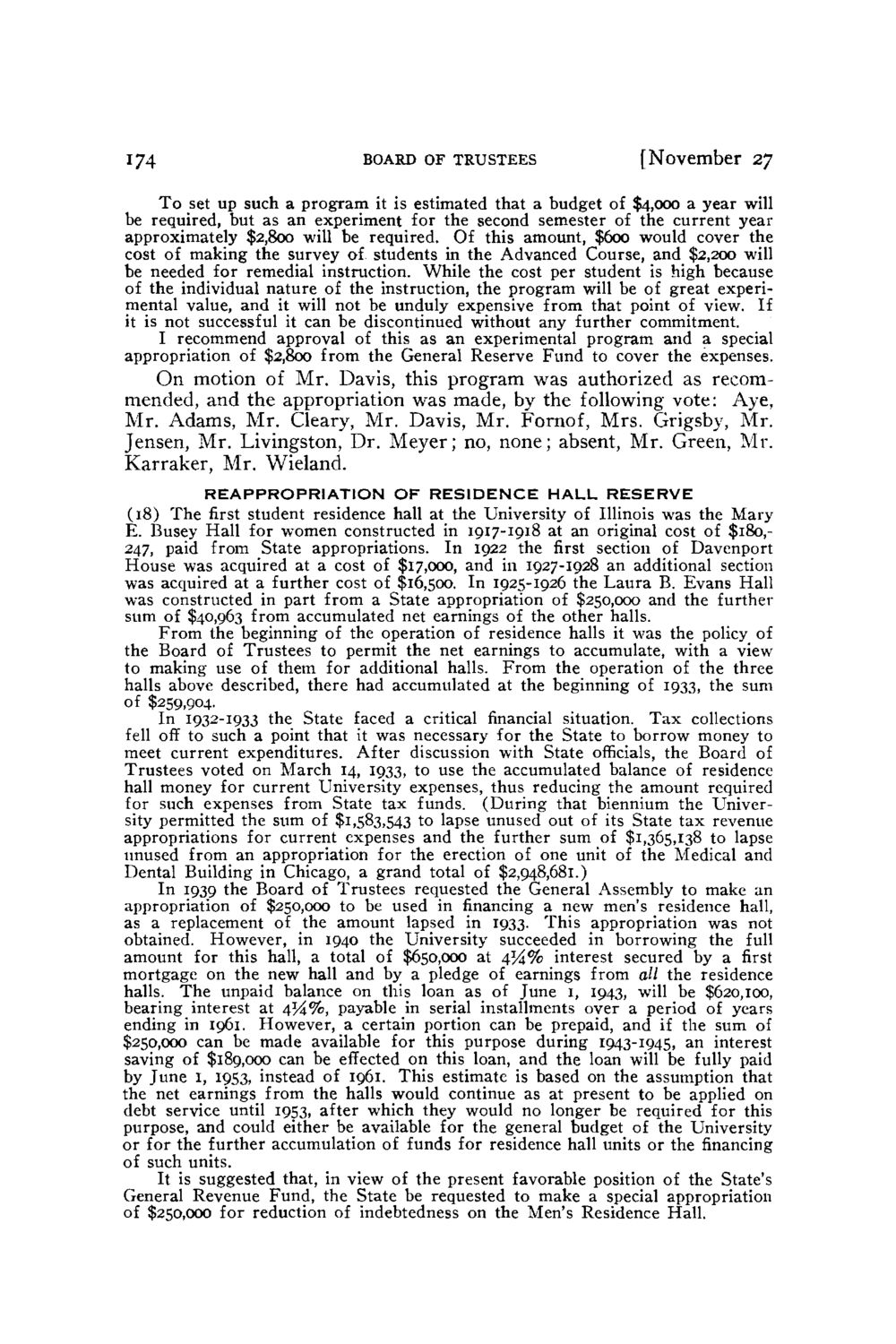| |
| |
Caption: Board of Trustees Minutes - 1944
This is a reduced-resolution page image for fast online browsing.

EXTRACTED TEXT FROM PAGE:
174 BOARD OF TRUSTEES [November 27 T o set up such a program it is estimated that a budget of $4,000 a year will be required, but as an experiment for the second semester of the current year approximately $2,800 will be required. Of this amount, $600 would cover the cost of making the survey of students in the Advanced Course, and $2,200 will be needed for remedial instruction. While the cost per student is high because of the individual nature of the instruction, the program will be of great experimental value, and it will not be unduly expensive from that point of view. If it is not successful it can be discontinued without any further commitment. I recommend approval of this as an experimental program and a special appropriation of $2,800 from the General Reserve Fund to cover the expenses. On motion of Mr. Davis, this program was authorized as recommended, and the appropriation was made, by the following vote: Aye, Mr. Adams, Mr. Cleary, Mr. Davis, Mr. Fornof, Mrs. Grigsby, Mr. Jensen, Mr. Livingston, Dr. Meyer; no, none; absent, Mr. Green, Mr. Karraker, Mr. Wieland. REAPPROPRIATION OF RESIDENCE HALL RESERVE (18) T h e first student residence hall at the University of Illinois was the Mary E. Busey Hall for women constructed in 1917-1918 at an original cost of $180,247, paid from State appropriations. In 1922 the first section of Davenport House was acquired at a cost of $17,000, and in 1927-1928 an additional section was acquired at a further cost of $16,500. In 1925-1926 the L a u r a B. Evans Hall was constructed in part from a State appropriation of $250,000 and the further sum of $40,963 from accumulated net earnings of the other halls. F r o m the beginning of the operation of residence halls it was the policy of the Board of Trustees to permit the net earnings to accumulate, with a view to making use of them for additional halls. F r o m the operation of the three halls above described, there had accumulated at the beginning of 1933, the sum of $259,904. In 1932-1933 the State faced a critical financial situation. T a x collections fell off to such a point that it was necessary for the State to borrow money to meet current expenditures. After discussion with State officials, the Board of Trustees voted on March 14, 1933, to use the accumulated balance of residence hall money for current University expenses, thus reducing the amount required for such expenses from State tax funds. (During that biennium the University permitted the sum of $1,583,543 to lapse unused out of its State t a x revenue appropriations for current expenses and the further sum of $1,365,138 to lapse unused from an appropriation for the erection of one unit of the Medical and Dental Building in Chicago, a grand total of $2,948,681.) In 1939 the Board of Trustees requested the General Assembly to make an appropriation of $250,000 to be used in financing a new men's residence hall, as a replacement of the amount lapsed in 1933. This appropriation was not obtained. However, in 1940 the University succeeded in borrowing the full amount for this hall, a total of $650,000 at 4%% interest secured by a first mortgage on the new hall and by a pledge of earnings from all the residence halls. T h e unpaid balance on this loan as of June I, 1943, will be $620,100, bearing interest at 454%, payable in serial installments over a period of years ending in 1961. However, a certain portion can be prepaid, and if the sum of $250,000 can be made available for this purpose during 1043-1945, an interest saving of $189,000 can be effected on this loan, and the loan will be fully paid by J u n e I, 1953, instead of 1961. This estimate is based on the assumption that the net earnings from the halls would continue as at present to be applied on debt service until 1953, after which they would no longer be required for this purpose, and could either be available for the general budget of the University or for the further accumulation of funds for residence hall units or the financing of such units. It is suggested that, in view of the present favorable position of the State's General Revenue Fund, the State be requested to make a special appropriation of $250,000 for reduction of indebtedness on the Men's Residence Hall.
| |